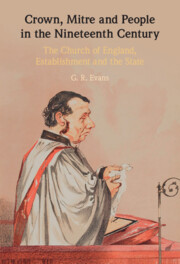 Crown, Mitre and People in the Nineteenth Century
Crown, Mitre and People in the Nineteenth Century Book contents
- Crown, Mitre and People in the Nineteenth Century
- Reviews
- Crown, Mitre and People in the Nineteenth Century
- Copyright page
- Contents
- Preface
- Abbreviations
- Legislation
- Table of Cases
- Introduction A National Church in the National Life
- Chapter 1 The Disputed Boundary between Church and State
- Chapter 2 What Happened in an Ecclesiastical Court?
- Chapter 3 Taking the Clergy to Court
- Chapter 4 Taking the Laity to Court
- Chapter 5 Not in the Church of England but …
- Conclusion
- Bibliography
- Index
Chapter 5 - Not in the Church of England but …
Published online by Cambridge University Press: 14 September 2021
- Crown, Mitre and People in the Nineteenth Century
- Reviews
- Crown, Mitre and People in the Nineteenth Century
- Copyright page
- Contents
- Preface
- Abbreviations
- Legislation
- Table of Cases
- Introduction A National Church in the National Life
- Chapter 1 The Disputed Boundary between Church and State
- Chapter 2 What Happened in an Ecclesiastical Court?
- Chapter 3 Taking the Clergy to Court
- Chapter 4 Taking the Laity to Court
- Chapter 5 Not in the Church of England but …
- Conclusion
- Bibliography
- Index
Summary
Nineteenth-century England had a large population of Christians who did not belong to the Church of England, and a proportion of Jews, though as yet almost no Muslims. The civic position of Jews had partly improved by this time. There was growing interest in the problems presented by what would now be thought of as ‘ecumenical relations’, with the first Lambeth Conferences giving the matter consideration, though excluding the Roman Catholics. This chapter explores the relationships between the main categories of non-Anglican Protestant Christians, including the ways in which they might be regarded as being part of the Church, that is, having an authentic ecclesial identity. The refusal of the Friends (Quakers) to take oaths was accommodated and the rights of Roman Catholics were thought through, with particular reference to Ireland. Dissenting academies were providing an excellent higher education.Problems were arising about the payment of clerical income and the costs of maintaining churches because non-Anglicans resented having to make a contribution.
Keywords
- Type
- Chapter
- Information
- Crown, Mitre and People in the Nineteenth CenturyThe Church of England, Establishment and the State, pp. 242 - 291Publisher: Cambridge University PressPrint publication year: 2021
